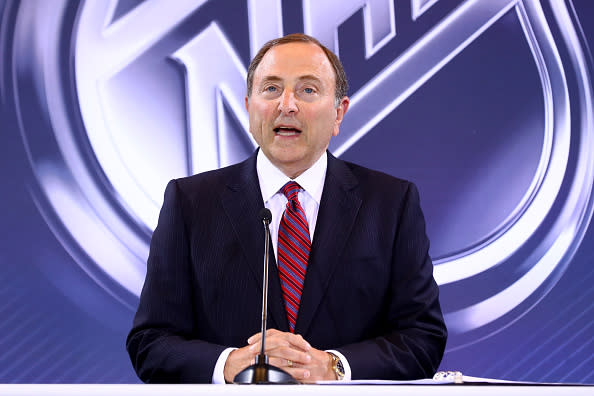NHL to use player-tracking technology for World Cup of Hockey

The NHL will use revolutionary player-tracking technology for the World Cup of Hockey, the league announced at a press conference in Toronto on Wednesday.
This is the type of equipment the NHL used at the 2015 All-Star weekend in Columbus. The belief was that it could be implemented into games as soon as the 2015-16 season, but commissioner Gary Bettman said he wanted to make sure the tech worked “the way it’s supposed to” before investing further.
Sportvision will provide this technology for the tournament.
“From our perspective this really allows fans to quantitatively understand the speed, the skill, the agility required to play the game at the NHL level,” Stephen McArdle, NHL executive vice president of digital media and strategic planning, told Puck Daddy. “Having the data to be able to tell the stories around what’s happening in the game – for this deployment it will be primarily on broadcast as well as postgame on the World Cup of Hockey website, to be able to really quantify the skating, stickhandling, shooting capabilities of players, but also I think for the broadcast partners and ESPN to be able to leverage and help tell the stories of the game in broadcast live, as well as replay postgame, they’ll have these tools available to really help them tell the complete story of what’s happening on the ice.”
Here is what was said by the league at the press event:
“We will be deploying that technology in both pucks, which are being manufactured as we speak, and player tags that will be used throughout the tournament.
The quantitative data that we will be tracking throughout this tournament will include puck and skating speed. It will include puck trajectory. It will include distance traveled for players as well as pucks, and will include other key data points that you see displayed here on the screen — data points which include spacing between players, obviously the (graphical) pointers to let fans know who is on the ice at any given time. Time on ice that can vary from shift to period to cumulatively throughout the game. And those tracking points, those data points, will be available live in broadcast. They’ll be made available for analysis during breaks, through replay use. And they’ll be made available for postgame or intermission use for our broadcast partners.”
McArdle said the league had to look at many factors after the 2015 All-Star Game before it decided on this larger-scale deployment.
“I think there’s a lot of considerations,” he said. “There are considerations with our partners in the event, the NHLPA. There are considerations around the economics. There are considerations about the data and how the data was going to be used and where the data was going to be used. All those things were discussed, continue to be discussed, so I wouldn’t characterize it as a holdup. I think I would characterize it as an ongoing evaluation and the format of this tournament, the duration of this tournament, the density of this tournament gives us a good opportunity to put many of the aspects of this system into place and learn a lot from it.”
At the news conference, McArdle said the puck manufacturing process had improved as well as some other factors that should help with the accuracy of the data, such as “increased the sample rate of the cameras capturing the data, so that we’re capturing data from both the pucks and the players on a more frequent basis to give us a more precise reading of both the pucks and players. We have improved the tag design … which will allow for better visibility for cameras and tracking.”
The league and the NHLPA are reportedly preparing 750 pucks with tracking equipment for the tournament. That way if they go into the stands, fans can keep them.
McArdle noted that Sportvision’s relationship with ESPN should help with the implementation for broadcasts.
“ESPN, they have sports scientists on staff, they’ve embraced tracking technology in other sports they cover in their broadcast,” McArdle said. “They’re comfortable with (it) and they know Sportvision very well through their actions with Sportvision in other sports and other leagues. So for them, this is almost a natural for them to be working with Sportvision and to be able to leverage data in the broadcast. It’s something they’re familiar with and they’re comfortable with.”
McArdle said there isn’t a timetable to implement player tracking into NHL games, but the World Cup itself should provide a large amount of data on how to use the technology moving forward.
“We’re viewing this as a scaled implementation for the World Cup only. We did not announce anything other than the World Cup today. So this will be an ability to put the entire system and the entire processes and the entire set of data that’s coming out of it through scaled deployment to really understand what it would be like to deploy this over the course of a real NHL season,” he said. “This is probably the best simulator that we have in this very dense period of time to do so. So we will take our time after the tournament to evaluate the data, evaluate reactions from the fans, evaluate reactions from the players and evaluate how the system itself performs before we move onto anything more permanent.”
– – – – – – –
Josh Cooper is an editor for Puck Daddy on Yahoo Sports. Have a tip? Email him at puckdaddyblog@yahoo.com or follow him on Twitter! Follow @joshuacooper

 Yahoo Sport
Yahoo Sport 







































